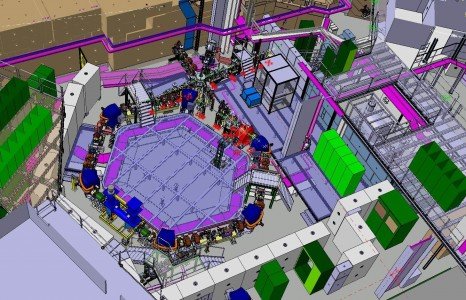Live from CERN - ELENA is so beautiful that antimatter gets slow
It is a long time that I have not reported any fresh news from what is going on at CERN. Let us now fix this and discuss antimatter and ELENA.
To recap a little bit, the CERN, in Geneva, is the largest physics laboratory in the world and is not only busy with the Large Hadron Collider (also known as the LHC). Many other experiments are currently ongoing, or will soon be starting, and all have their importance.
I have already blogged a bit about antimatter, and I will continue with this post. I will in particular discuss a brand new ring that has been completed with the aim of slowing down antimatter particles. This ring is called ELENA (as I said earlier, particle physicists like funny names, although this one is brighter than the DarkSide experiment I discussed the other day.
ANTIMATTER IN A NUTSHELL
Before moving on, the first question to briefly discuss is definitely about the nature of antimatter and what it is exactly.
In the microscopic world, everything that lies around us is made of a small set of constituents. Those building blocks for matter could be different according to the domain of physics one is focusing on.
While a particle physicist may be interested by quarks and leptons, it is sometimes easier to rewrite our theory differently and replace all quarks that lie in there by composite objects like protons, neutrons and others. This is what I will do here, exactly like in my quantum mechanics lectures for Steemit.
Each particle is charaterized by a bunch of properties like its mass, its electric charge, its lifetime and in general a finite ensemble of quantum numbers (the electric charge being actually one of them). We are living in the quantum world after all, and we need for quantum numbers.
At each particle corresponds an antiparticle: protons and antiprotons, neutrons and antineutrons, etc. And this could be generalized at any level of size. For instance, one has quarks and antiquarks, electrons and positrons, hydrogen atoms and anti-hydrogen atoms, to name a few pairs of particle-antiparticles.
The differences between a particle and an antiparticle are small. This originates from the CPT symmetry, one of the most fundamental symmetry of nature. To repeat myself once again, everything is connected to symmetries in the microscopic world!
This CPT symmetry tells us that a particle and an antiparticle are identical up to the quantum numbers that are opposite. For instance, a proton has a charge of +1 unit, while an antiproton has a charge of -1. And so on. The mass, the lifetime, and all other properties are totally identical (this is actually a symmetry).
ANTIMATTER AT CERN: THE NEEDS FOR BEING SLOW
Several experiments are focusing on the study of the antimatter at CERN, like the ASACUSA experiment I have discussed earlier on Steemit.
These experiments in general start with a beam of antiprotons whose properties are further investigated by the experiment itself. The long-term goal is to assess the validity of the CPT symmetry, test it and pushing the frontier of knowledge to a further extent.
In order for these studies to proceed nicely, one needs to slow down any freshly produced antiproton as much as possible. Slow antiprotons are for instance the key ingredients for forming anti-hydrogen atoms obtained by combining an antiproton with a positron.
ELENA AND THE ANTIPROTONS
And this is how ELENA enters into the game.
As I said earlier, we physicists like funny names and acronyms. ELENA stands for Extra Low ENergy Antiproton. Now you know everything about the reason why I have used capital letters! A sketch of ELENA can be found below.

[image credits: the ELENA experiment ]
But what is precisely ELENA? ELENA looks like an accelerator and it possibly even smells like one, although I have not had the chance to verify that by myself. ELENA is however not an accelerator.
It is a ring of 182 meters long (for the sake of the comparison, the LHC is a ring of 27 km long) that is used to slow down antiprotons that are injected inside it. ELENA is thus an antiproton decelerator.
It is capable to reduce the kinetic energy of the antiprotons to a very small level of 10% of its mass energy.
IN DETAILS
How does ELENA work? To make a long story short: it works in the same way that particles are accelerated. Electric and magnetic fields are used to control the antiproton trajectory and act on their speed. In short, this means employing magnets.
For achieving the goals, the designers of ELENA have however had to fight not so minor perturbations, like the magnetic field of the Earth to name one of them.
Earth's magnetic field is very weak, but it is as weak as those applied to the beam. They could thus interfere significantly. The solution involves very intense weak field counteracting the external perturbations.

[image credits: pixabay
And now comes the fun part. In order to study an antiproton, one needs to trap it, like to Schrödinger cat in the picture above.
Thanks to ELENA, the probability to manage trapping an antiproton will be increased by a factor of 10 to 100. This means more antiprotons to feed the experiments with, further antimatter studies, more confidence in the existing studies and maybe new experiments and new challenges to tackle!
ELENA is actually so big that it can feed four experiments in parallel!
WHY DISCUSSING ABOUT ELENA NOW
Because the decelerator ring has just been completed and the first beam has circulated in it.
[image credits: a CERN press release]
The ELENA team at CERN is now moving on with the next steps of the projects, which consists of checking whether everything works as it should and commissioning the machine.
It is now time to clap :)
Cool. I mentioned antimatter in a post earlier today :)
https://steemit.com/science/@rmach/useless-information-13-the-most-expensive-materials-in-the-world
I am puzzled by this mention... I have added a comment :)
Thanks for another informative post. You make very good explanation of difficult (on first view) and interesting things.
Thanks a lot for your comment!